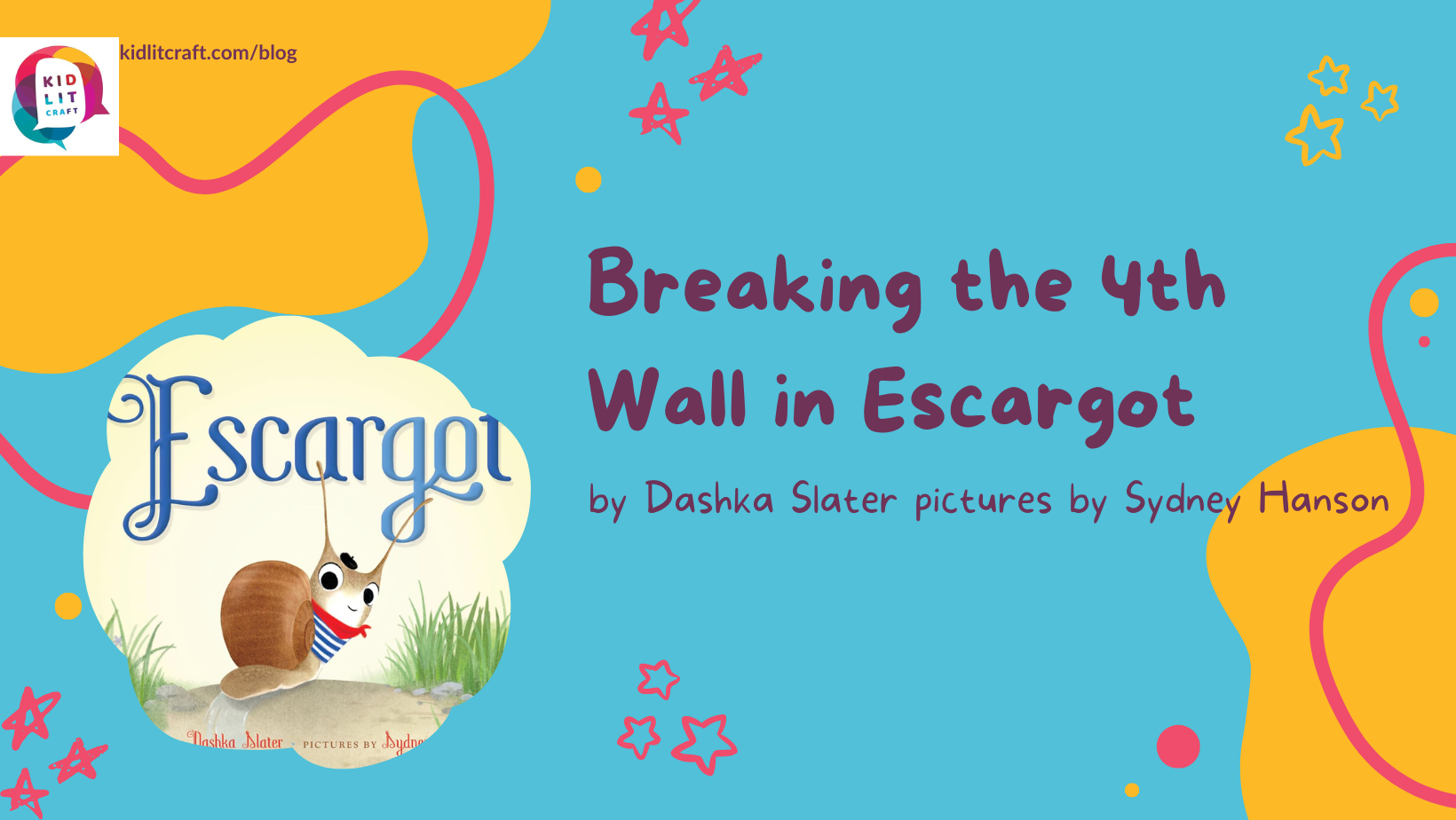craft review by Kristi Wright

Escargot, written by Dashka Slater and illustrated by Sydney Hanson, is a charming, funny, interactive picture book, ideal for picky eaters and animal lovers alike, that breaks the fourth wall. When writers talk about breaking the fourth wall, they are referring to a concept that originated in theatre where there are three walls to a stage and a fourth imaginary wall between the audience and the actors. If an actor communicates directly with the audience, they are “breaking the fourth wall.” Likewise, in literature, if either a character or a narrator talks directly to the reader, they are breaking the fourth wall. (This can also be called “direct address.”)
Escargot uses a number of techniques to directly engage the reader, such as posing questions to the reader and asking them to do physical actions, like turning the page or giving Escargot a kiss.
In this craft post, we’re looking directly at how the author was able to break the 4th wall, but when you read Escargot (and you really should), pay close attention to how the illustrator breaks the 4th wall too. Notice how Escargot is almost always looking out of the book at the reader. A child (never fully revealed) acts as surrogate for the reader by picking up Escargot and accepting his kiss. But the reader knows via the words and the illustrations that Escargot is interacting with them.
Here are six techniques Slater uses to break the fourth wall (and you can too!)
PROVIDE A STORY GOAL THAT READERS CAN PARTICIPATE IN
Immediately, Escargot states that he’s traveling to the beautiful salad at the end of the book. He tells the reader:
You should come! I just need a little push to help me start.
The reader now has the question: Will Escargot make it to the beautiful salad at the end of the book? And they are an active participant in the story, being asked to help Escargot get there.
MAKE READERS ROOT FOR YOUR MC
Slater’s main character is a lowly snail, but his personality is adorable and Hanson’s illustrations of him, in his Paris stripes and jaunty beret, reinforce his cuteness. Escargot starts by reminding readers that:
Nobody ever says their favorite animal is the snail.
He imagines that readers might have negative thoughts about snails:
Perhaps you think, “Snails are slimy, Escargot! You are too slimy to be my favorite animal.”
Now that he’s painted himself as an underdog, he can build the case for why snails are wonderful, starting with the slime being
“more like shimmery trails…of shimmery stuff.”
MAKE THE MAIN CHARACTER RELATABLE
Most kids don’t like all their veggies. Neither does Escargot. Right away, he declares:
Escargot does not eat carrots.
In a delightful twist toward the end, Escargot makes a deal with the reader that he will try the carrot in the salad if the reader will try it too.
POSE QUESTIONS DIRECTLY TO THE READERS:
Escargot peppers the reader with questions:
Tell me, what do you think is my most beautiful part?
Do you also make a shimmery trail?
What is your favorite kind of salad?
Cleverly, Slater lets Escargot chatter away, answering many questions himself. His running commentary reads well even if the child doesn’t directly answer Escargot’s questions.
PROVIDE OPPORTUNITIES TO PHYSICALLY INTERACT:
Throughout, Escargot offers readers opportunities to be physically engaged with him.
When he’s about to tell the reader something sad, so sad he might cry, he asks,
Will you stroke my shell, just until I feel better?
Can you blow on me to cool me off?
When he’s scared and hides in his shell, he asks:
Do you want me to come out?
Really?
Then you must say,
“Come out, Escargot!
Come out and I promise I will never put a carrot in your salad.
Come out and I will kiss you!”
He even insists on racing the reader to the salad at the end of the story.
AND FINALLY, GO FOR A SWEET PAYOFF:
Throughout the story, Escargot has been laying the groundwork for a sweet ending that’s perfect in every way, but also a slight twist. Escargot repeats multiple times that he would like the reader to name the snail as their favorite animal.
But in the end, it’s Escargot who tells the reader:
You are magnifique.
In fact…you are my favorite animal.
And so, I kiss you!
Mwah!
This turnabout is so sweet, sure to transform any child into an Escargot fan, even if they don’t commit to snails being their favorite animal.
NOW IT’S YOUR TURN
Are you working on a project where you break the fourth wall? If so, consider the following:
- Can your reader be an active participant in the story goal?
- Are there traits you can give your MC that make them super relatable?
- What questions can your MC (or narrator) ask that will engage your reader?
- Are there opportunities for the reader to physically interact with your MC?
- What’s the sweet payoff? If the reader engages with your MC over the course of the book, what’s their reward at the end?
Find Slater and Hanson on social media:
For more craft tips related to Picture Books, check out:
Kristi Wright (co-editor) writes picture books and middle grade novels. Her goal as a writer is to give children a sense of wonder, a hopefulness about humanity, and a belief in their future. She is represented by Kurestin Armada at Root Literary. She is an active volunteer for SCBWI and a 12 X 12 member. Find her at www.kristiwrightauthor.com and on Twitter @KristiWrite.


COMMENTs:
0